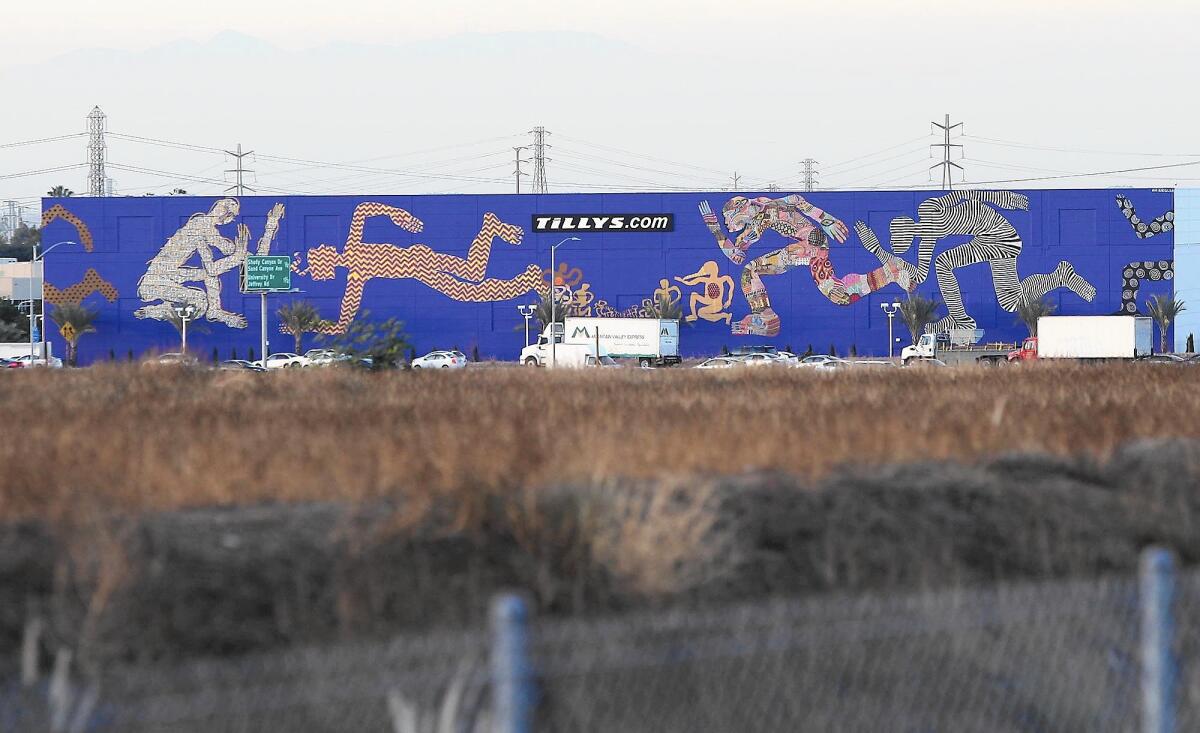Tilly’s mural prompts discussion in Irvine about public art

In July, artist Zio Ziegler climbed aboard a hydraulic boom lift and was elevated to the “canvas” looming in front of him — the 55-by-340-foot wall of the building housing the offices of Tilly’s clothing retailer in Irvine.
In only a couple of days, a mural took shape. In it, athletic-looking figures, each in a different pattern — some might say a zebra print, repeating circles, a sort of psychedelic paisley — appear to be running across a deep-blue background.
The sudden eye-catching splash in a city not known for color became a point of interest for commuters on the northbound 405 Freeway who might not have time in the notoriously unpredictable traffic flow in the area to study the intricacies of the work but could pause later and wonder: Where did that come from? What is it? What does it mean?
It came from a collaboration among Ziegler, Laguna Beach art gallery Artists Republic for Tomorrow and Vans, the Cypress-based shoes and clothing company, with the approval of the Irvine Planning Commission.
But the planners’ OK gave the mural only 90 days. Then it would have to be destroyed. Torrey Cook, founder of Artists Republic, also known as AR4T, went back to the commission and a couple months ago won more time for the artwork — until next June.
When asked if he will do the work of destroying his own art, Ziegler seemed to gasp as he said, “That would be heartbreaking for me.”
Anthony Kuo, Planning Commission chairman, said he sees no more reprieves in the mural’s future.
“I think it’s the end of this particular mural, but there is an appetite to discuss what we will do in the future,” said Kuo, who although he had concerns about the mural when it was proposed joined with the majority in approving it. All five members of the panel agreed to the later extension.
*
Not meant to last
Michelangelo’s painting in the Sistine Chapel has lasted nearly 500 years. Leonardo da Vinci’s “Mona Lisa” is about as old.
Ephemeral art, on the other hand, is meant to have a short shelf life. It is meant to shine bright, make a powerful impression and then be gone, though ideally it will live on in the consciousness of its viewers, Ziegler would say.
“Ephemeral art [is] not a movement, per se, but has been an aspect of human creativity since we started making marks and objects, which would include ritual as well as ‘art,’” Joanna Roche, an art history professor at Cal State Fullerton, wrote in an email. “But in terms of contemporary art — post WWII — it is a not-uncommon practice of many artists to make work that is short-lived and meant to be experienced by its viewers over specific durations of time.
“This would include performance art, earth art — works that use nature/earth — and a broad category of artistic practice referred to as street art. This includes graffiti, stencil art and other mark-making in the urban environment.”
Last month, for example, artist Laddie John Dill presented his “Electric Light Blanket,” a show of light and laser effects shining from the cliffs in Laguna Beach to the city’s Main Beach and beyond. He collaborated with Laserium, a manufacturer of laser projection systems, followed the necessary process with the Federal Aviation Administration so that pilots could be alerted, and proceeded to plan the show. The performance piece delivered four hours of choreographed laser light sequences and then was dismantled.
Ziegler, 27, knew going in that his work in Irvine would be short-lived.
“As a conceptual artist, I am fine with its decay and destruction, but from a humanistic perspective, as someone who loves Southern California, I don’t understand why it has to go,” said the artist, who lives in the Bay Area.
He appreciates the evolution of art and the power of the ephemeral.
“I read once that good art fades, all things, beautiful faces, even in Flemish art when one apple has a blemish,” he said. “If you think of painting, during the Renaissance, it was to heighten, to elevate for time immemorial. So I see the very value.
“Art used to be preserving something against time itself. It’s now almost a sort of an ally with the transitory nature of the world. So instead of art fighting time, we are an ally. It’s the works that don’t fight the motivation of time but that succumb to that inevitability of decay.”
He also talks of art that is expedited. That he covered 15,000 square feet of space in the time that it might take another artist to set up his supplies speaks to the speed of his process. (His girlfriend and a couple of other people helped to apply 20 to 30 gallons of paint while Ziegler wielded about 100 canisters of spray paint to carve out the detail.)
And he does little planning. “My planning is all intellectual,” Ziegler said. “I don’t actually sketch or plan or necessarily render anything before I touch the surface of the wall, but I have thought a lot about the significance before I touch the wall. It’s not visual yet. I make it up.”
Art critic Ivan Quaroni has been quoted as saying that Ziegler “is the new enfant prodige of California street art, capable of making big graffiti pieces in record time,” noting he did three large murals in Milan, Italy, in a few days.
*
Muralism vs. street art
But Ziegler, who studied at the Rhode Island School of Design and Brown University, said that although his early influence in art came from graffiti, he would like to draw a line.
“Street art and muralism should not go under the same heading,” he said. “Muralists are conceptually motivated. They have technical ability that harkens back to art education or traditionalism. They understand things in painting, in scale. ... The street artists seem more motivated in the graffiti tradition to put a lot of stuff up to mark territory. More kitsch, not the deep-seated artist motivation.”
Indeed, while England-based graffiti artist and political activist Banksy might have a reputation as a respectable street artist, street markings often are associated with urban blight and gang activity.
Evan Senn, a Southern California art critic who specializes in street art, said: “In the ‘80s, it was almost kind of like a race. It also had to do with location. The less visible will last longer.”
That’s why taggers aim for the “heavens,” meaning the hard-to-reach places like the sides of freeway overpasses. Such feats are dangerous for the graffiti artists, who might hang off ledges or other protrusions in the middle of the night to create, but the graffiti also will be hard to remove.
“I know a lot of muralists who started in street art, who have that in their blood still,” Senn said. “It’s a race. To get it up, to make it look pretty is the whole thing. It doesn’t matter if it goes away in a week or so.”
Ziegler sees murals as having the “power to make people so compelled to look but also be unable to process in one setting. The art always eludes.”
He has been quoted as saying that the meanings of his symbols “are as ephemeral as the process itself.”
Ziegler references mandalas but declines to delve into any interpretation of his art.
“That closes down your perception of what you thought it was,” he said. “I don’t want to over-define that.”
Rather, he wants to empower the viewer.
Referring to the estimated daily freeway traffic flowing by the Tilly’s mural, he said that “500,000 people can live with their own stories. That piece is intended to be a catalyst for individual thought. Open-source hieroglyphics.”
*
New look for Irvine
Greg Escalante, a Huntington Beach art collector and founder of art magazine Juxtapoz, speaks of how Miami has been enlivened by Wynwood Walls, which brings together the world’s greatest artists working in the graffiti and street art realm, and Art Basel, which also stages art shows in the Florida city.
About the Tilly’s mural, Escalante said: “It looks really cool. I was happy and surprised to see it there. There is some art that wasn’t there before.”
Whether Ziegler’s mural is permanent or not, he has prompted the city of Irvine to reconsider its reputation for being beige.
“In a different conversation, let’s talk about reviving public art, within the context of communities having certain life,” said Planning Commissioner Kuo. “People have come to me and said, ‘Irvine, you are vanilla and stodgy.’ I would never want someone to paint their house chartreuse in Woodbridge, but at the edge of town.... [When in Los Angeles], I always saw murals. Sometimes they are fun to look at.”
Plus, he said, “I am always interested in bringing positive attention to the city.”
Ziegler said he has great respect for Kuo and others in Irvine government. Still, he decries what he sees as “the machinery of the bureaucracy,” which amounts to following Section 7-2-1 of the city zoning ordinance, having do with special sign regulations.
“I was so touched by people writing letters in support,” the artist said. “I want to be an advocate. You want a permanent mural? Let me do another that can stay. Or if I am not the person, let me find the artist that can.
“It would be much different if there would be another mural in its place — that’s nature,” Ziegler said, again referring to artwork that is by its definition fleeting. “But to revert to a beige wall doesn’t quite add up. We have a foot in the door of creating public art in Irvine. That means you are creating hope in tons of young students.”
He too points to Miami’s arts scene.
“Public art brings foot traffic to a city,” Ziegler said. “People can meet other individuals. It decreases xenophobia, opens dialogue, bridges community, stimulates young businesses, opens artists’ careers.”
